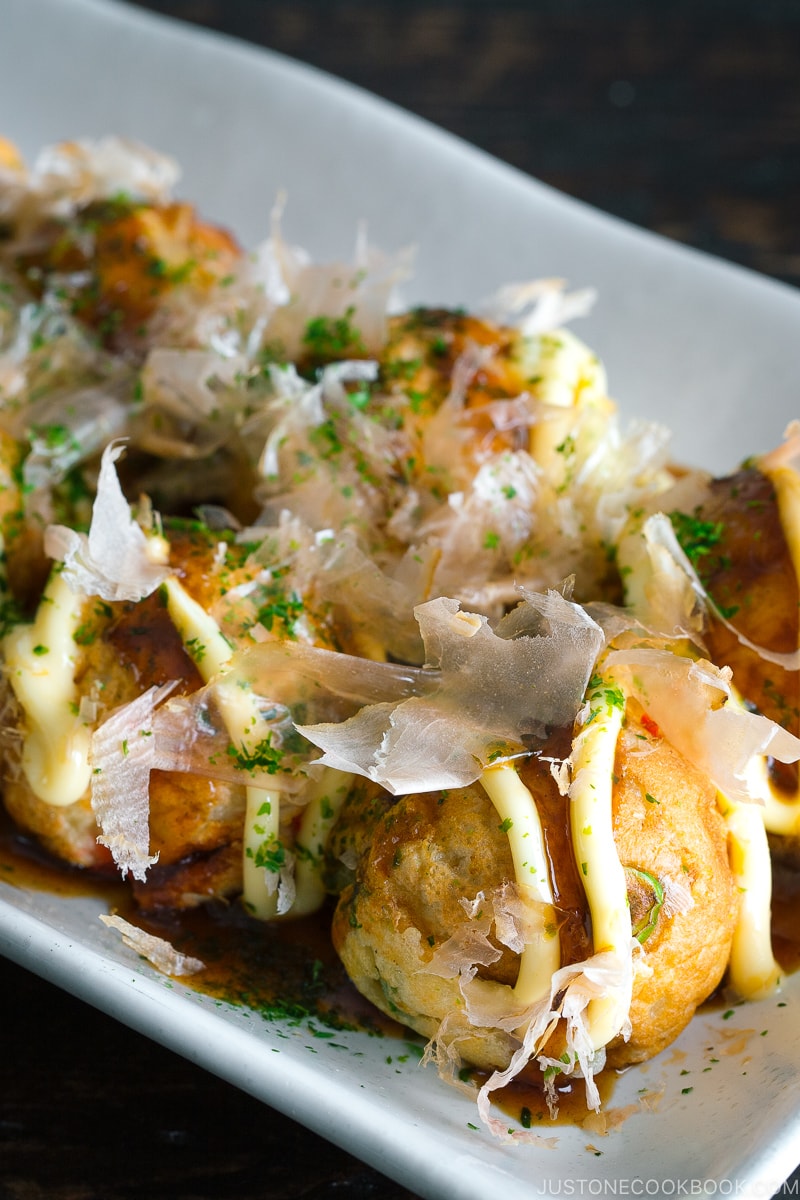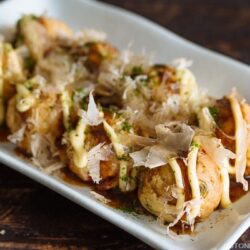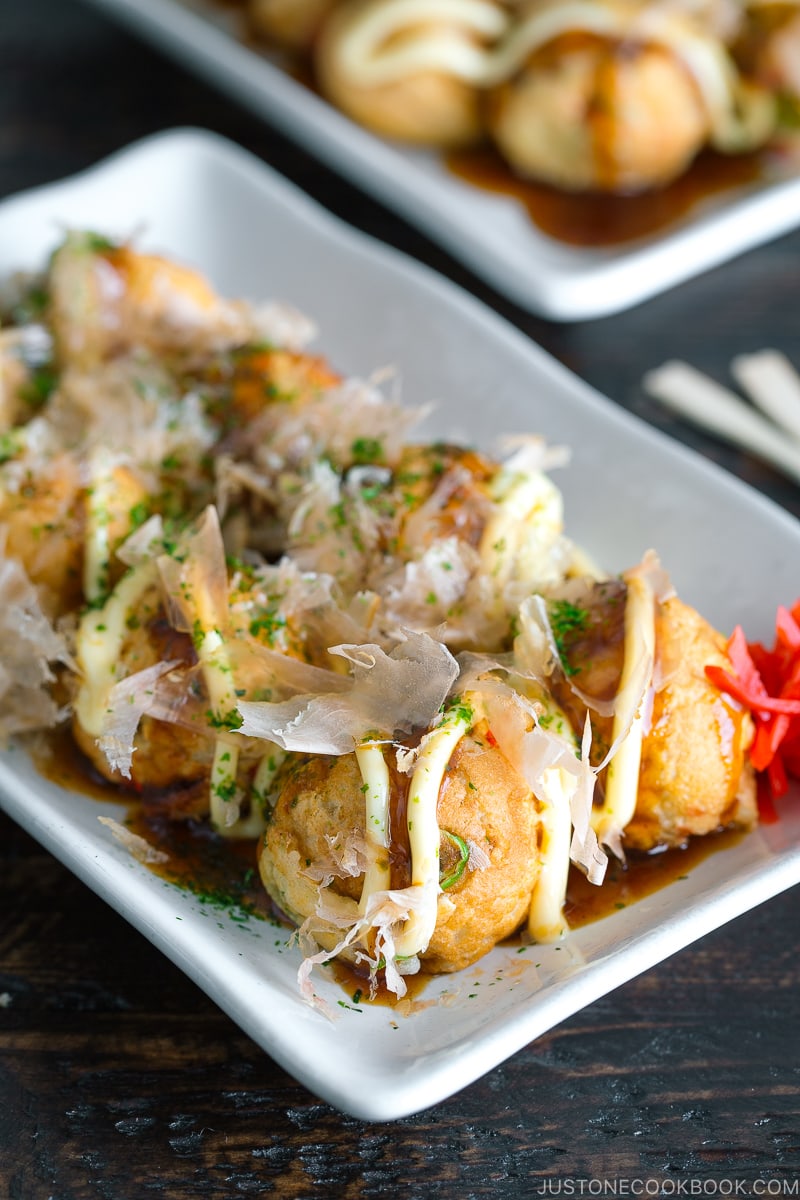
Takoyaki (たこ焼き) is a Japanese snack in the shape of little round balls containing pieces of octopus. Tako-yaki literally translates to “octopus-grilled/fried” and some people may call it “Grilled Octopus Balls” or “Octopus Dumplings”.
What is Takoyaki
Here are some facts about takoyaki.
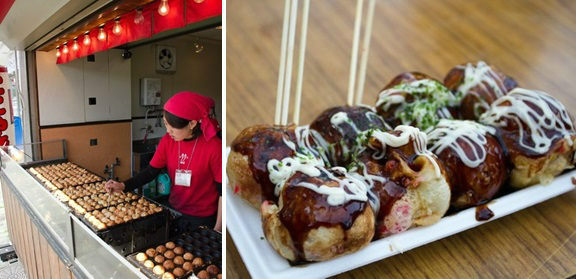
- It originated and became popular in Osaka around 1935 (according to wiki) and then spread to greater south-central Japan and beyond.
- It’s one of the most popular Japanese street foods along with Okonomiyaki.
- Takoyaki is usually sold by street vendors, convenience stores, supermarkets, food courts, and of course specialty restaurants. In Osaka, takoyaki stands can be easily found throughout the city.
- It is usually served with slightly salty takoyaki sauce, which goes well with beer and other alcoholic drinks. Therefore, many Izakaya restaurants serve takoyaki on the menu.
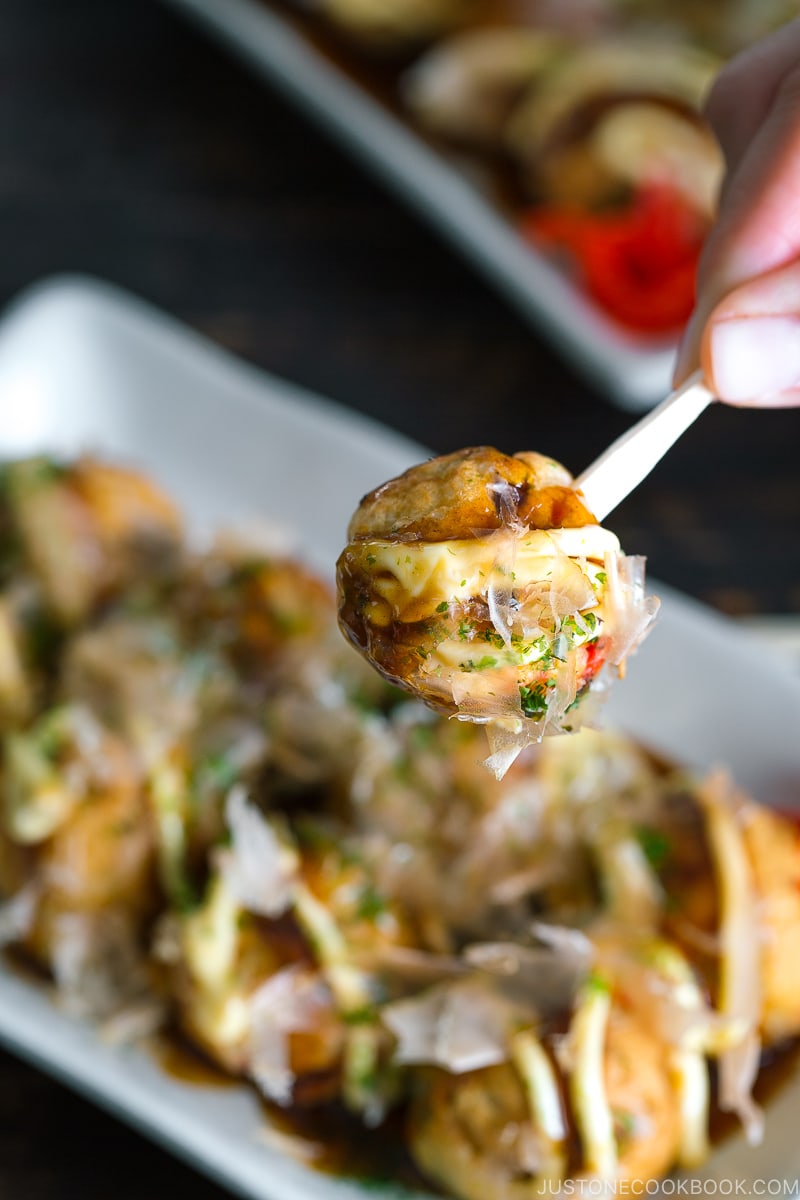
5 Ingredients for Authentic Takoyaki
There are so many variations of takoyaki throughout Japan. For example, the original Osaka-style does not include any cabbage, but many regional variations (Kyoto, Kobe, Nagoya, Tokyo areas) do. Even though I lived in the Tokyo area, I actually didn’t know they sometimes contain cabbage till now.
Here are the ingredients for the classic takoyaki recipe.
1. Dashi-flavored batter
Very simple. It’s a mixture of Japanese stock Dashi, all-purpose flour, baking powder, eggs, salt, and soy sauce. If you don’t want to make the batter from scratch, you can find takoyaki mix in Japanese grocery stores or Amazon.
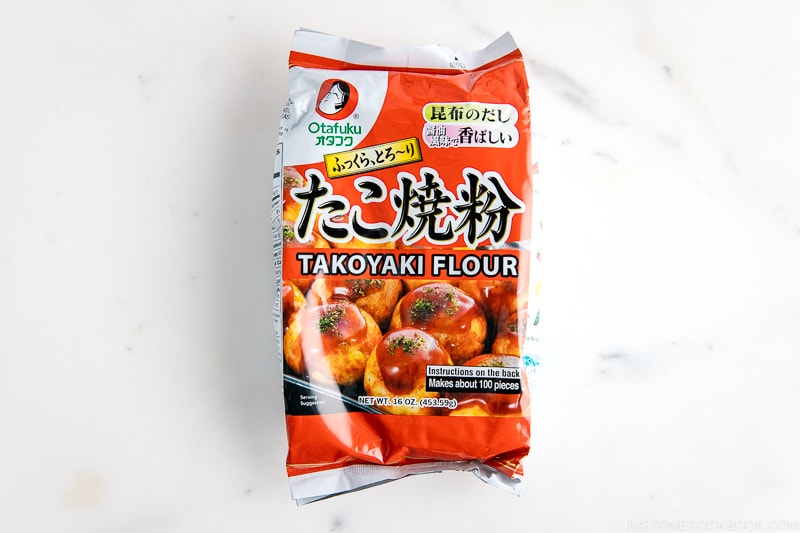
2. Octopus
You can purchase cooked (boiled) octopus (tako in Japanese) in Japanese grocery stores. If you are going to make this snack for a big party, you can purchase a whole cooked octopus at an online sashimi store like Catalina Offshore. When I buy a whole octopus, I use it for different dishes, including sashimi, carpaccio, octopus salad (Takosu), and of course, takoyaki.
3. Beni shoga (pickled red ginger)
Small bits of beni shoga (紅生姜), or red pickled ginger, give a nice pop on the color of takoyaki and a little spicy, pungent kick to the dish.
4. Green onion
The batter is yellow, octopus, and beni shoga are red… and now you need green color to make the dish look more appetizing (and delicious)!
5. Tenkasu or Agedama (Tempura scraps)
I often get questions about what Tenkasu does for the dish. We use tempura scraps for hot or cold Tanuki Udon Noodles and Okonomiyaki (even Hiroshima-style). The oil from Tenkasu adds richer and umami flavors, and additional crispness and creaminess inside takoyaki balls.
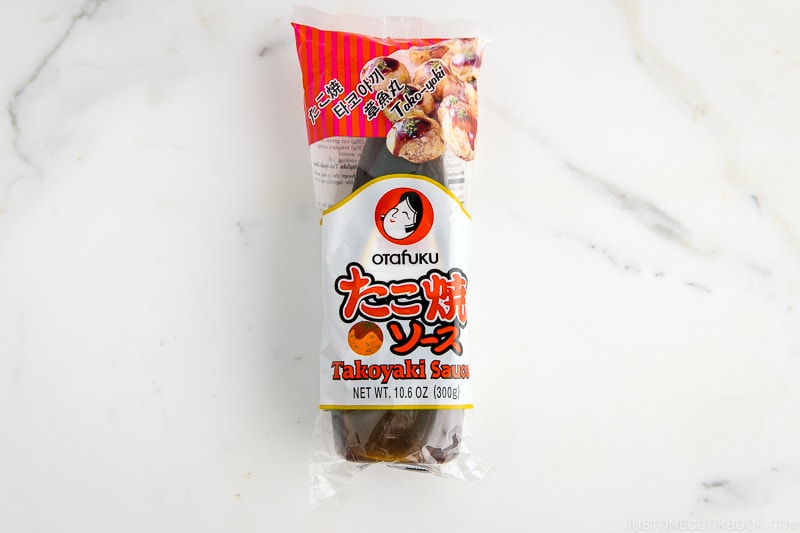
Takoyaki Sauce & Garnish
Takoyaki is served with Worcestershire sauce-like “takoyaki sauce”, followed by some squirt of Japanese mayo. You can:
- Buy a store-bought takoyaki sauce
- Make a quick homemade takoyaki sauce (recipe) with several condiments
Then it’s topped with a sprinkle of a few garnishes:
- Aonori (dried green seaweed)
- Katsuobushi (dried bonito flakes)
3 Tips to Make Perfect Takoyaki
I received many requests for this recipe from JOC Readers (thank you!). To make the recipe as authentic as possible, I asked my best friend Yukako who lives in Osaka. She makes delicious takoyaki at home and she and her husband shared their own recipe with me and JOC readers. Yay! I adapted the recipe a little bit so that some ingredients will be easier to measure.
Tip 1: Don’t be stingy with the oil.
Apply generous oil everywhere (each hole in the takoyaki pan and surrounding flat area). How generous? You should see 1/4 inch (5 mm) oil in each hole. The oil helps takoyaki to have crispy skin and it’ll be easier for you to flip without the batter being stuck.
Tip 2: Generously pour the batter.
When you see smoke coming out of the grill/plate, fill the hole with the batter. If it overflows, that’s okay. Because the entire grill top should be covered with the batter after adding octopus and other ingredients in the hole. If you use a bigger chunk of octopus pieces, you might want to pour just enough to the top of the holes. As soon as the octopus goes in, it overflows naturally.
Tip 3: Flip 90 degrees and stuff in the extra batter.
Break the extra batter around the hole with skewers. Once the bottom of the takoyaki balls is crispy, rotate 90 degrees to let the uncooked batter pour out into the hole. Stuff and push in the extra surrounding dough inside the balls. This will help make a perfectly round shape.
For a home takoyaki grill, each hole doesn’t provide the same amount of heat. Therefore, it’s important to switch around the balls once they are in a ball shape so they’re browned evenly.
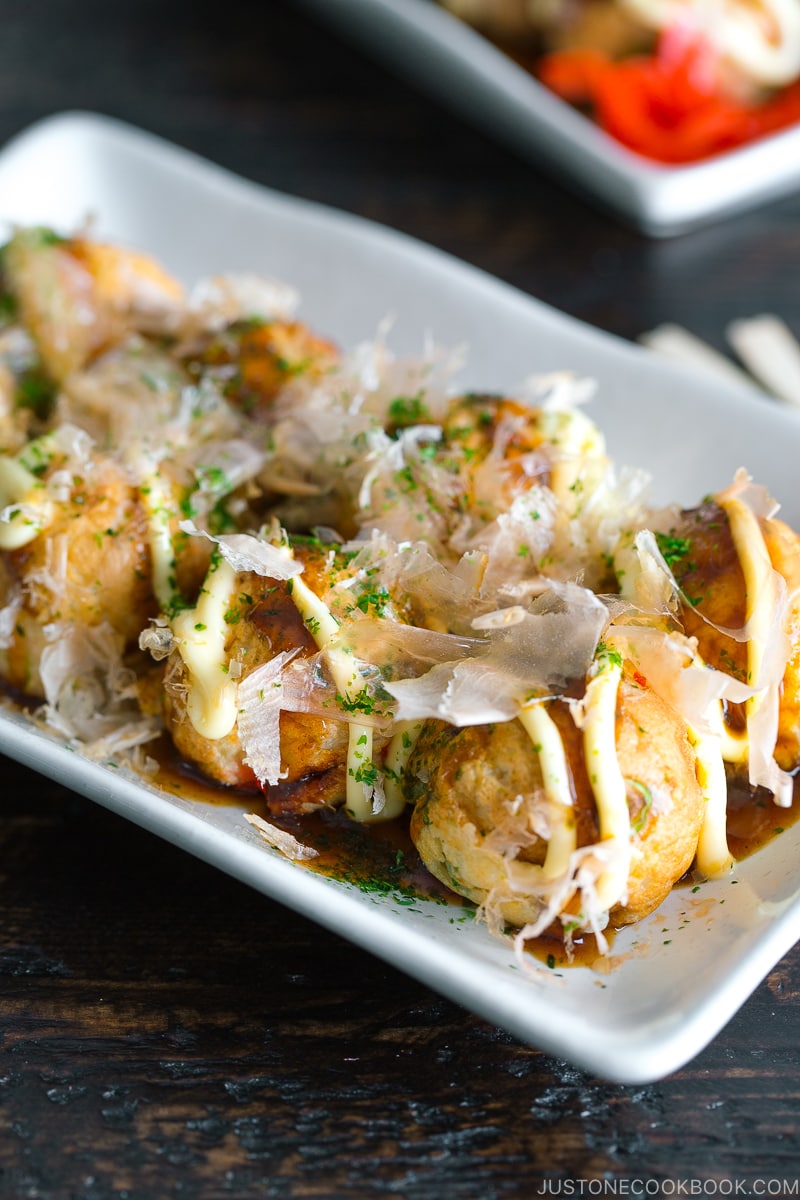
Don’t Like Octopus? Here Are Substitutions!
No problem! A lot of Japanese children enjoy different fillings besides pieces of octopus. Here are my suggestions for other fillings.
- Sausages / Bacon
- Canned tuna / Mentaiko (Spicy cod/pollock roe)
- Shrimp / Squid
- Cheese
- Mochi (rice cakes)
- Fish cake (chikuwa/crab sticks)
- Kimchi
- Corn
- Edamame
- Green peas
- Avocado
Other Japanese Street Foods
- Yakisoba
- Okonomiyaki
- Taiyaki
- If you are interested in learning about Japanese Street Foods, check out Japanese Summer Festival Foods.
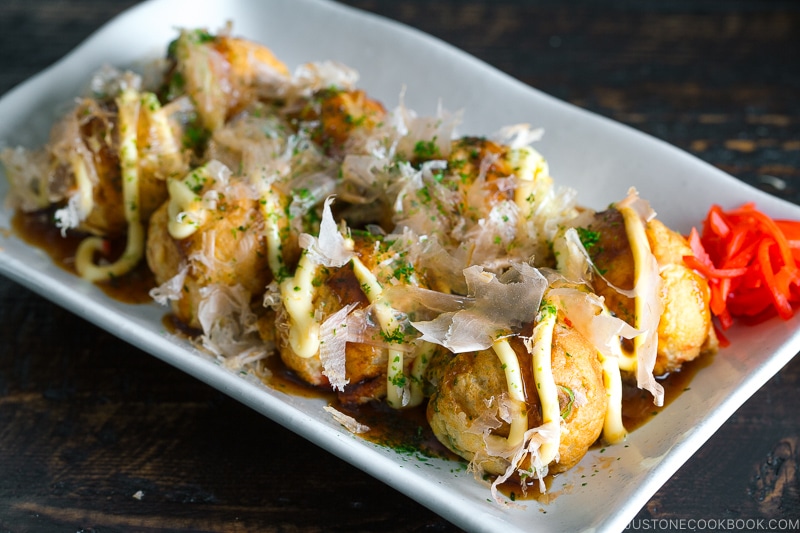
Wish to learn more about Japanese cooking? Sign up for our free newsletter to receive cooking tips & recipe updates! And stay in touch with me on Facebook, Pinterest, YouTube, and Instagram.
Takoyaki (Grilled Octopus Balls)
Ingredients
- ¼ cup katsuobushi (dried bonito flakes) (I use the type with bigger flakes)
- 2 green onions/scallions
- 1 Tbsp pickled red ginger (beni shoga or kizami beni shoga) (store bought or make homemade Beni Shoga)
- 4.2 oz octopus sashimi (boiled octopus) (found in Japanese grocery stores; or substitute with sausage, corn, edamame, cheese, small mochi pieces…the choices are endless!)
For the Batter
- 1 cup all-purpose flour (plain flour)
- 2 tsp baking powder
- ½ tsp Diamond Crystal kosher salt
- 2 large eggs (50 g each w/o shell)
- 1 tsp soy sauce
- 1½ cups dashi (Japanese soup stock) (use standard Awase Dashi, dashi packet or powder, or Vegan Dashi)
For Cooking
- 2 Tbsp neutral oil
- ⅓ cup tenkasu/agedama (tempura scraps)
For the Toppings
Instructions
- Gather all the ingredients.
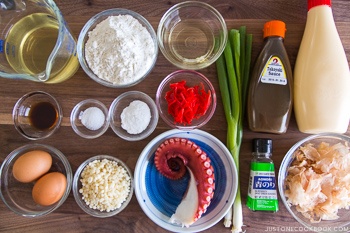
To Prepare the Filling
- Grind ¼ cup katsuobushi (dried bonito flakes) into a fine powder. Set aside to use during cooking.

- Cut 2 green onions/scallions into thin slices and mince 1 Tbsp pickled red ginger (beni shoga or kizami beni shoga).

- Cut 4.2 oz octopus sashimi (boiled octopus) into bite-sized pieces about ½ inch (1.3 cm); I use the rangiri cutting technique. Tip: Cut it into smaller pieces so it's easier to chew, especially for kids.

To Make the Batter
- Combine 1 cup all-purpose flour (plain flour), 2 tsp baking powder, and ½ tsp Diamond Crystal kosher salt in a large mixing bowl. Whisk it all together.
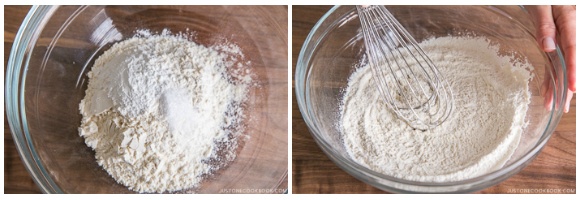
- Add 2 large eggs (50 g each w/o shell), 1 tsp soy sauce, and 1½ cups dashi (Japanese soup stock) to the bowl.
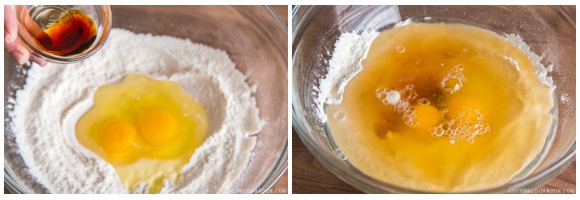
- Whisk until well blended. Transfer it to a handled measuring cup or any pitcher with a spout for easy pouring.
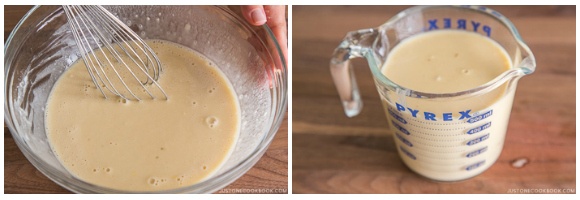
To Cook the Takoyaki
- Heat the takoyaki pan to 400ºF (200ºC) over medium heat. Use a brush to generously grease the rounded chambers and flat top surface with 2 Tbsp neutral oil. When the oil starts to smoke, pour the batter to fill the chambers. It’s okay to slightly overfill the cavities. In the next steps, the batter will likely overflow as you add more ingredients to it.

- Add 1–3 octopus pieces, depending on their size, to each chamber and sprinkle the ground katsuobushi powder on top.
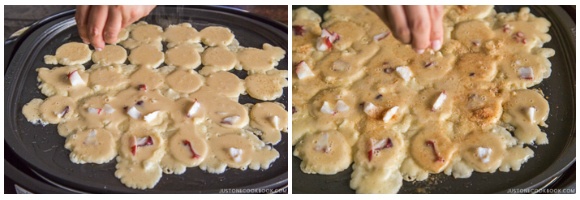
- Sprinkle ⅓ cup tenkasu/agedama (tempura scraps), the green onion slices, and the chopped pickled red ginger on top. After 3 minutes or so, when the batter on the bottom has set and is slightly crisp, use skewers to break the connected batter on top between the chambers. Rotate each piece 90 degrees (a quarter turn) toward the bottom of the pan. Stuff the connected dough back into the ball as you turn; the uncooked batter will flow out from inside to create another side of the ball. After you finish turning them, set a timer for 4 minutes.
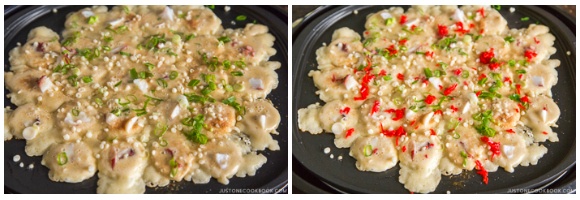
- After 4 minutes, rotate them again, starting with the first ball. Turn each takoyaki another 90 degrees toward the bottom of the pan so the remaining uncooked batter pours out into the chamber to complete the ball shape. Home takoyaki griddles don‘t distribute heat evenly, so it’s a good idea to swap the balls around to different chambers so they brown evenly. After turning and cooking for another 4 minutes, they are done.

To Serve
- Transfer them onto a plate and drizzle with ½ cup takoyaki sauce and Japanese Kewpie mayonnaise. Sprinkle with katsuobushi (dried bonito flakes) and aonori (dried green laver seaweed) and serve with a side of pickled red ginger (beni shoga or kizami beni shoga). Serve immediately. (But, be careful—they‘re VERY hot inside!)

To Store
- You can keep the leftovers in an airtight container and store in the refrigerator for 3 days or in the freezer for 2–3 weeks.
Nutrition
Did you make this recipe?
Tag @justonecookbook on Instagram so we can see your delicious creation!
Editor’s Note: The post was originally published on Oct 20, 2013.


